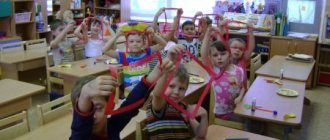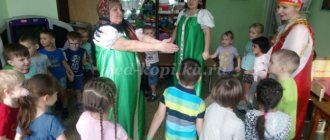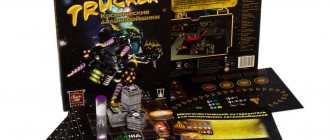Planning a theater week (senior group)
Alesya Chistova
Planning a theater week (senior group)
Theater Week
Group No. 5. “School No. 2115” SP5
Tasks:
— creating conditions for the development of children’s creative activity (equipping the room, preparing attributes, costumes,
music and lighting design);
- introducing children to theatrical culture (types of theatrical art, features of theatrical art, theater from the outside and from the inside,
viewer culture);
— development of speech: diction, speech breathing; developing in children an attitude towards clear and concise speech as the basis for successful communication;
training in the ability to conduct dialogue and monologue;
- development of children’s thinking abilities, imagination, fantasy, perception, attention (drawing up a logical chain
works, the ability to improvise, draw conclusions, defend one’s point of view);
— development of verbal and non-verbal forms of communication (mastering expressive movements and intonations, the ability to listen to the interlocutor);
— development of the emotional sphere (sympathy, empathy, development of the ability to correctly express one’s feelings)
— development of sustainable interest in theatrical activities.
Topics Contents of work Forms
Monday.
"We came to the theater"
The first half of the day.
1. Introduction to the concept of theater: (showing slides, paintings, photographs). Types of theaters (musical, puppet, dramatic, etc.).
Purpose: to give children an idea of the theater; expand knowledge of theater as an art form; introduce types of theaters; cultivate an emotionally positive attitude towards the theater.
2 Introduction to theatrical professions (artist, make-up artist, hairdresser, musician, decorator, costume designer, actor).
Goal: to form children’s ideas about theatrical professions; to intensify interest in theatrical art; Expand words knowledge.
3. Display of illustrations and photographs of Moscow theaters.
Goal: to introduce children to the structure of the theater building, to draw attention to the originality of the architecture and the beautiful facade of different types of theater.
Afternoon
1. Plot-role-playing game “We came to the theater.”
Purpose: to introduce the rules of behavior in the theater; arouse interest and desire to play (play the role of “cashier”, “ticketer”, “spectator”); cultivate friendly relationships.
2. Conversations about the rules of conduct in the theater, give the concept of the proverb “Spectator culture”.
Goal: To give children an idea of the rules of conduct in public places; to form a personal attitude towards non-compliance and violation of rules.
Working with parents:
Design of an information stand (moving folder) “Theater and Children”. Conversations with parents on the topic of the week.
Tuesday.
Morning
Solving riddles about the theater.
Goal: to teach children to recognize by description various concepts of the topic (Buffoons, director, dialogue, makeup, puppeteer, poster, scenery, wig, etc.), to activate them in speech and clarify them. Develop logical thinking, maintain interest in the topic being studied.
The first half of the day.
1. Acquaintance with the types of theaters for children (tabletop, bibabo puppet theater, puppets).
Goal: to introduce children to different types of theaters; deepen interest in theatrical games; enrich your vocabulary.
2. Looking at bi-ba-bo dolls with children.
A conversation about how to use dolls correctly and an educational story “The history of the appearance of bi-ba-bo dolls.”
"Funny essays."
A retelling of one of the familiar fairy tales using elements of puppet theater.
Goal: Encourage children to compose simple stories with characters from familiar works. Cultivate a sense of humor and help improve children's self-esteem. Develop children's coherent speech.
Afternoon
1. Theatrical puppet show.
Goal: To develop children's interest in performing arts.
2. Psycho-gymnastics “Different faces”.
Goal: Encourage children to experiment with their appearance (facial expressions, gestures). Develop children's ability to switch from one image to another.
3. Independent activity of children in the theater corner. Sketches with tabletop dolls based on well-known Russian folk tales.
Goal: improve puppeteering techniques, consolidate knowledge about the rules for manipulating theatrical puppets of different systems
Working with parents:
Recommendations for parents on choosing fiction for children.
Wednesday.
The first half of the day.
1. Introducing children to finger theater, mask theater, shadow theater.
Goal: to give children an idea about the features of this type of theater.
2. Finger gymnastics “Bird”, “Owl” and others.
Goal: speech development, development of intelligence, spatial thinking, creative abilities of children.
3. Work with one of the types of theaters:
- examination of characters;
- dialogues: wolf - fox, wolf - bear, mouse - wolf.
Goal: To develop the ability to build dialogues between characters in imaginary circumstances. Develop children's coherent speech and expand their figurative speech. Monitor the expressiveness of the image.
4. Game “Create a funny and sad dialogue between the Mouse and the Bunny.”
Goal: Develop communication skills; diversify intonation expressiveness; pay special attention to children's diction.
Walk.
Quiz, simulation exercises “Fairy-tale characters”.
Goal: to teach children to recognize the characters of familiar fairy tales by description, by excerpts of the work, to portray the heroes of fairy tales. Develop logical thinking and artistic abilities.
Afternoon.
Game "Try it yourself." Finger theater "Straw bull" (at the teacher's choice). Goal: to develop children’s ability to use finger theater in free activity; distribute characters; convey the characteristic features of the heroes of the fairy tale.
Children's games with sounding instruments.
Goal: to give children an idea of the musical design of performances.
S/r game “A trip to the puppet theater”.
Purpose: To acquaint children with the structure of the theater building, to draw attention to the originality of the architecture and the beautiful facade. Enrich children's vocabulary.
Work with parents: invite parents to get acquainted with the posters of Moscow theaters whose repertoire includes children's performances.
Thursday.
The first half of the day
1. Game exercise “Pierrot and Harlequin”.
Goal: to teach children to perform morning exercises, acting in the form of various characters, to change the nature of movements, their dynamics in accordance with the task.
Enrich the motor, communicative and social experience of children.
2. “We are artists!” Conversation with children about theater actors’ costumes, makeup, etc.
What role would you like to play?
Goal: to consolidate knowledge about the theatrical life of actors behind the scenes, to develop creative imagination in children
3. Reading the poem by A. Barto “In the Theater.”
4. "Acquaintance with puppets."
Goal: Improve puppeteering techniques, consolidate knowledge about the rules of manipulating theatrical puppets.
Afternoon.
S/r game “We are artists” (production of a fairy tale well known to children).
Purpose: To acquaint children with the scenario (direction) of a fairy tale. Teach children to express their opinion about a fairy tale in a new way. Complete the tale with the necessary episodes. Cultivate the ability to listen to the opinions of others, develop endurance and patience.
Walk.
Games based on the fairy tales “By the Bear in the Forest”, “Geese-Geese”, “The Sly Fox”, “The Little Gray Bunny Is Sitting”.
Work with parents: introduce parents to various types of theatrical games, principles and techniques of their organization, developmental and educational opportunities.
Friday.
The first half of the day.
1. Introduction to musical theaters.
Purpose: To give an idea of the various genres of musical theater, such as “opera”, “ballet”, “musical”, “musical fairy tale”.
2. Acquaintance with the musical design of performances. Examination and playing of musical and noise instruments in order to teach children the sound design of scenes from fairy tales.
3. Psycho-gymnastics.
Goal: Learn to use intonations, pronouncing phrases sad, happy, angry,
surprised. Learn to build dialogues by choosing your own partner. Bring up
endurance, patience, complicity.
“Sad and cheerful puppy” (based on the fairy tale by N. Suteev “Who said meow?”); "Phrase in a circle"
Afternoon.
1. Game technique “Guess who it is?”
Goal: to identify a character from a fairy tale based on the nature of the music.
2. Voice-over of a fairy tale chosen by the children using noise instruments. Encourage
Adding attributes to the musical corner (xylophone, whistles, pipes, tambourines, etc.) Images of a ballet production, opera, musical. Disc with children's songs for
improvisation.
Working with parents:
invite parents, together with their children, to convey their impressions received during the theater week through visual activities.




